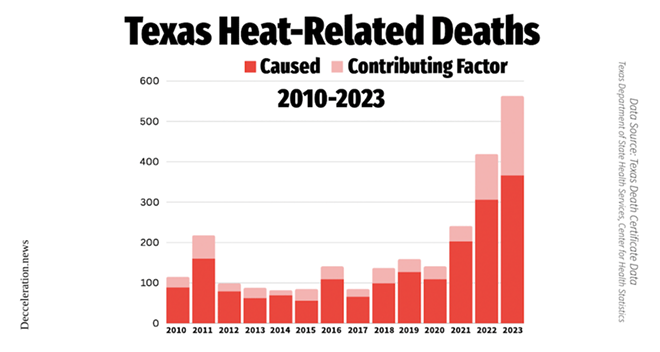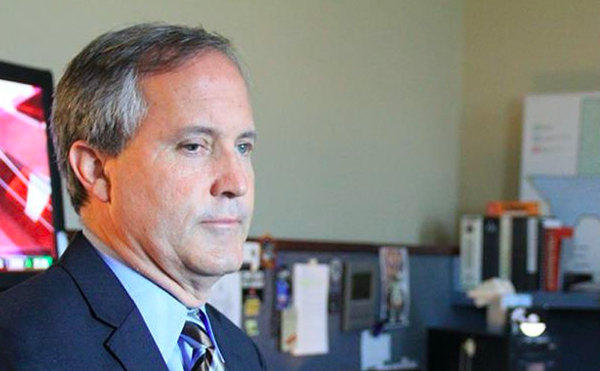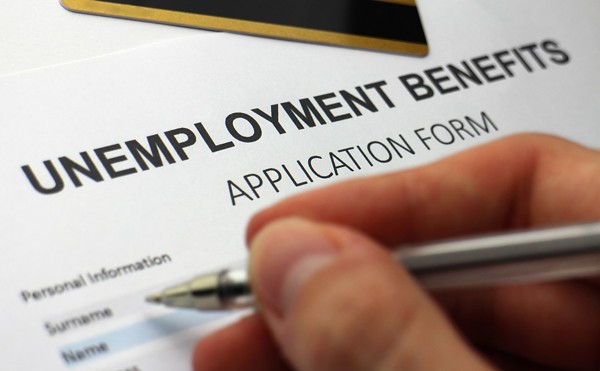
When Donald Trump and Kamala Harris faced off for their first — and likely only — debate before the November election, they offered next to no reflection on the climate crisis. A habitable planet just hasn’t become a top-shelf concern for most voters even as land and sea temperatures hurtle headlong into unprecedentedly hot territory thanks to the continued accumulation of greenhouse gases in the atmosphere, primarily caused by the burning of fossil fuels.
Increasingly, the cost of our fossil fuel dependence is showing up in city and county morgues. Recent research suggests that there has been a 117 percent rise in heat-related deaths in the United States since 1999, most noticeably since 2020, as the Earth returns to sweltering temps that likely haven’t been seen in more than 125,000 years.
Here in the United States’ most prolific oil and gas-producing state, a whopping 563 heat-related deaths were recorded last year, according to state data released to Deceleration by open-records request.Similar to national-level findings, heat deaths in Texas have grown most dramatically over the last three years. In 2022, for instance, there were 419 heat-related deaths in the state. There were 241 the year before that. In 2020, 141 residents succumbed to the heat. This is all the more remarkable considering that heat-related deaths over the previous decade averaged about 124 per year, according to Deceleration’s analysis of state data.
“I think a lot of people are on the cusp of having an ‘Oh shit’ moment about extreme heat,” Texas A&M University climate scientist Andrew Dessler wrote Deceleration. “Hotter temperatures do not mean tank tops and grilling in the backyard. It means, at best, changing how we live. At worst, it means suffering and death.”
Several of these numbers are significantly higher than most previous reports. In January, the Texas Tribune, for example, reported 334 heat-related deaths in the state in 2023. According to the most recent data, heat was the primary cause of death in 366 of last year’s 563 heat-related deaths; the remaining 197 deaths involved extreme heat as a contributing cause of death.
It’s too early in the year to know how 2024 mortality figures will shape up. While global heat has continued to rise virtually unabated, and 2024 is almost certain to replace 2023 as our hottest year ever recorded, Texas’s summer temps eased off a smidge—and are likely to “only” rank around our fourth or fifth hottest.
However, painful losses continued to accumulate. Last month, 46-year-old Jessica Witzel died on a sidewalk in the Five Points area of San Antonio, an apparent victim of both the urban heat island effect that focuses heat disproportionately toward more severely denuded urban areas, and the failures of local networks of care that are supposed to help those in crisis.
This year, the San Antonio Metropolitan Health District stopped publicly reporting heat deaths after more than a decade of attempting to include them alongside cases of heat illness and heat stroke. Over the last decade, Metro Health has only reported one heat-related death. Report after report published only “N/A,” not available, for the category. However, in April of this year, Deceleration uncovered at least 28 heat deaths in Bexar County since 2019.
Deceleration reached out to a handful of City Council members about the state of local heat-busting efforts. Councilmember John Courage released a statement to Deceleration that included recognition of the extremes hitting local communities. Last year, he said, was “extraordinary” for its intense temperatures and resulting heat illnesses and deaths.
“As our city continues to experience rising temperatures due to climate change, the safety and well-being of San Antonio residents remain a top priority,” Courage wrote, before highlighting current public heat education efforts and the expansion of cooling centers across the city.“We are continuously working to integrate heat emergency preparedness into San Antonio’s long-term planning, helping us build a more resilient city in the face of future extreme weather events.”
A spokesperson for the Texas Department of State Health Services said that they were aware of dozens of deaths collected from across the state during June and July. They cautioned, however, that it can take many weeks before death certificates reach the state. Likely it won’t be until November or December that anything resembling a complete accounting of 2024’s summer will be available.
In April, Deceleration reported that there had been 357 heat-related deaths in Texas in 2023. However, this figure fails to include cases where heat was determined to be a contributing cause of death. Heat-related death data in Texas is divided between primary causes of death and contributing causes of death, as recorded in death certificates signed off on by an attending physician, medical examiner, or Justice of the Peace.
The distinctions matter, yet both are critical to understanding heat’s full impact on public health. Deceleration’s charts today are the first, to our awareness, that contain a full accounting of heat-related deaths in Texas since 2010 that are maintained by the state.
It is critical to include both methodologies when reporting on heat deaths, said Christina VandePol, a Pennsylvania physician and former coroner who speaks frequently on the hazards of heat.
“Many ‘excess deaths’ during a heat wave occur because people with underlying medical conditions are more sensitive to heat than otherwise healthy individuals,” VandePol told Deceleration. “In other words, but for that heat stress, they might not have died.”“Without counting M2 deaths, we don’t have a full picture of the human harm caused by hotter temperatures,” VandePol said. “Without that full picture, we don’t know there’s a problem and can’t find solutions needed to save lives.”
Deceleration has been highlighting failures in local heat accounting to suggest wider failures in understanding heat-related deaths in Texas. In October of 2023, for instance, we wrote about how lack of reliable data was hobbling efforts in Bexar County, where the medical examiner has said repeatedly (through two different media liaisons) that they do not track heat deaths. Last year, the National Association of Medical Examiners issued a policy paper urging medical examiners to document disaster-related deaths, including heat waves and hyperthermia.
In April, we highlighted Nueces County, where the operations manager for the Nueces County Medical Examiner’s Office told Deceleration that heat deaths are rarely recorded by his office due to insufficient local surveillance efforts.
Last month, reporters from the Texas Tribune and Inside Climate News collaborated to investigate if and how local and state government are underestimating heat’s deadly impact. The team highlighted cases from around the state, spotlighting Bexar County and noting Nueces. In that effort, the team included both Method 1 and Method 2 deaths in their accounting, stating that “[s]tate records report that 365 people died directly from heat, the most heat-caused deaths on record. The count rises to 562 when including deaths where heat was a contributing cause.”

For 2022, the Tribune previously reported that “at least 279 heat-related deaths were recorded last year, the highest annual toll for the state since at least 1999, according to data from the Texas Department of State Health Services.”
But Texas saw 419 heat-related deaths in 2022, according to the most recent data available. There were 306 deaths where heat played a primary role, and another 113 deaths where heat was listed as a contributing factor, according to state data provided to Deceleration.
Experts across various sectors are on the record that heat deaths are being undercounted, including in the workplace. The Occupational Safety and Health Administration, only now developing what could be the first national standard for preventing health-related workplace injuries after decades of pressure, recently described workplace heat deaths as likely a “vast” undercount.
A Research Letter published late last month in the Journal of American Medical Association (and kindly passed to Deceleration from a contributing writer at Yale Climate Connections) found that annual heat-related deaths in the United States rose from 1,069 in 1999 to 2,325 in 2023—a 117 percent increase. The rise has been the most dramatic since 2020. The team, including a lead author based at University of Texas at San Antonio, concludes that it is also a trend unlikely to subside any time soon.
“As temperatures continue to rise because of climate change, the recent increasing trend is likely to continue,” the team write. “Local authorities in high-risk areas should consider investing in the expansion of access to hydration centers and public cooling centers or other buildings with air conditioning.”
Lead author Jeffrey Howard, an associate professor at UTSA’s Department of Public Health, said that even the team’s high numbers are still almost certainly an undercount as previous studies have repeatedly demonstrated more excess deaths during severe heat waves than are officially accounted for on death certificates as heat-related deaths.
There are also issues with training and lack of basic medical knowledge about each person who has died.
“There are always going to be some number of deaths that were set in motion by excessive heat exposure, but it is just not known and the person filling out the death certificate does not list it because they are not aware of those details,” Howard wrote Deceleration.
Consider also that there are only about a dozen medical examiners operating across Texas, mostly in the large cities, and sometimes serving multiple counties. In much of the state, it is justices of the peace (who aren’t typically medical professionals) marking down causes of death. But even attending physicians may also fail to recognize or report heat’s human toll, VandePol told Deceleration.
In July, VandePol wrote that in spite of recent guidance to document heat deaths, chronic underreporting continues by coroners and medical examiners.
“Physicians in the community may fail to recognize heat as a contributing factor when someone dies of a heart attack, stroke, or kidney failure. Even when physicians suspect heat exposure, they may not be aware they must report such deaths.”
To fully appreciate how heat-related deaths are impacting the state requires also considering where people are dying from heat being caused by global energy decisions.
After reviewing Deceleration’s heat death maps, Dessler noted the large number of heat deaths that have congregated in and around the Rio Grande Valley.
“That’s a very poor part of Texas, so it clearly shows how the poor will bear the brunt of the suffering,” Dessler said. “When rich people say ‘we’ll adapt,’ they mean they’ll adapt and the poor will suffer and die.”Subscribe to SA Current newsletters.
Follow us: Apple News | Google News | NewsBreak | Reddit | Instagram | Facebook | Twitter| Or sign up for our RSS Feed


















